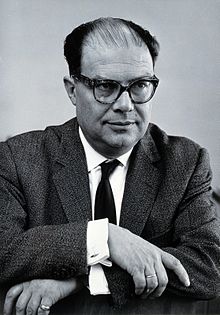Giulio Racah
Giulio Racah | |
|---|---|
 | |
| Born | February 9, 1909 Florence |
| Died | August 28, 1965 (1965-08-29) (aged 56) Florence |

The Racah Institute of Physics at the Hebrew University Givat Ram campus in Jerusalem
Giulio (Yoel) Racah (Hebrew: ג'וליו (יואל) רקח; February 9, 1909 – August 28, 1965) was an Italian–Israeli physicist and mathematician.[1]
Contents
1 Biography
2 Awards
3 See also
4 References
5 External links
Biography
Born in Florence, Italy,[2] he took his degree from the University of Florence in 1930, and later studied in Rome with Enrico Fermi. In 1937 he was appointed Professor of Physics at the University of Pisa. In 1939, due to application of Anti-Jewish laws in Italy, Racah immigrated to the British Mandate of Palestine, and was appointed Professor of Theoretical Physics at the Hebrew University of Jerusalem, where he was later Dean of the Faculty of Sciences, and finally Rector and acting President. The physics institute at the Hebrew University is named "The Racah Institute of Physics".
In the Israeli War of Independence, Racah served as deputy commander of the Israeli forces defending Mount Scopus.[3]
Racah's research was mainly in the fields of quantum physics and atomic spectroscopy. He first devised a systematic general procedure for classifying the energy levels of open shell atoms, which remains to this day the accepted technique for practical calculations of atomic structure. This formalism was described in a monograph coauthored by his cousin Ugo Fano (Irreducible Tensorial Sets, 1959).
Racah died at the age of 56, apparently asphyxiated by gas from a faulty heater.[4]
Awards
In 1958, Racah was awarded the Israel Prize in exact sciences.[5]
See also
- Racah's symbol
- Racah's V-coefficient
- Racah's W-coefficient
- Racah–Wigner calculus
- Racah parameter
- Racah polynomials
- List of Israel Prize recipients
- The Racah Institute of Physics
The crater Racah on the Moon is named after him.
References
^ "Giulio Racah". Physics Today. 18 (10): 118. Bibcode:1965PhT....18j.118.. doi:10.1063/1.3046917..mw-parser-output cite.citation{font-style:inherit}.mw-parser-output .citation q{quotes:"""""""'""'"}.mw-parser-output .citation .cs1-lock-free a{background:url("//upload.wikimedia.org/wikipedia/commons/thumb/6/65/Lock-green.svg/9px-Lock-green.svg.png")no-repeat;background-position:right .1em center}.mw-parser-output .citation .cs1-lock-limited a,.mw-parser-output .citation .cs1-lock-registration a{background:url("//upload.wikimedia.org/wikipedia/commons/thumb/d/d6/Lock-gray-alt-2.svg/9px-Lock-gray-alt-2.svg.png")no-repeat;background-position:right .1em center}.mw-parser-output .citation .cs1-lock-subscription a{background:url("//upload.wikimedia.org/wikipedia/commons/thumb/a/aa/Lock-red-alt-2.svg/9px-Lock-red-alt-2.svg.png")no-repeat;background-position:right .1em center}.mw-parser-output .cs1-subscription,.mw-parser-output .cs1-registration{color:#555}.mw-parser-output .cs1-subscription span,.mw-parser-output .cs1-registration span{border-bottom:1px dotted;cursor:help}.mw-parser-output .cs1-ws-icon a{background:url("//upload.wikimedia.org/wikipedia/commons/thumb/4/4c/Wikisource-logo.svg/12px-Wikisource-logo.svg.png")no-repeat;background-position:right .1em center}.mw-parser-output code.cs1-code{color:inherit;background:inherit;border:inherit;padding:inherit}.mw-parser-output .cs1-hidden-error{display:none;font-size:100%}.mw-parser-output .cs1-visible-error{font-size:100%}.mw-parser-output .cs1-maint{display:none;color:#33aa33;margin-left:0.3em}.mw-parser-output .cs1-subscription,.mw-parser-output .cs1-registration,.mw-parser-output .cs1-format{font-size:95%}.mw-parser-output .cs1-kern-left,.mw-parser-output .cs1-kern-wl-left{padding-left:0.2em}.mw-parser-output .cs1-kern-right,.mw-parser-output .cs1-kern-wl-right{padding-right:0.2em}
[permanent dead link]
^ "Archived copy". Archived from the original on 2012-10-12. Retrieved 2011-01-18.CS1 maint: Archived copy as title (link)
^ Jewish Virtual Library, sourced from Encyclopaedia Judaica
^ "Giulio Racah". Physics Today. 18 (10): 118. Bibcode:1965PhT....18j.118.. doi:10.1063/1.3046917.
[permanent dead link]
^ "Israel Prize recipients in 1958 (in Hebrew)". Israel Prize Official Site. Archived from the original on February 8, 2012.
External links
Timeline (at Racah Institute of Physics at Hebrew University)
Link to Racah Crater on Google Moon
This article about an Italian mathematician is a stub. You can help Wikipedia by expanding it. |
This article about an Israeli scientist is a stub. You can help Wikipedia by expanding it. |
This article about a physicist is a stub. You can help Wikipedia by expanding it. |